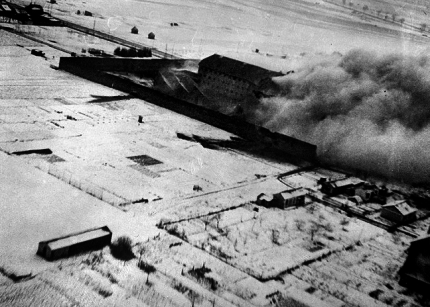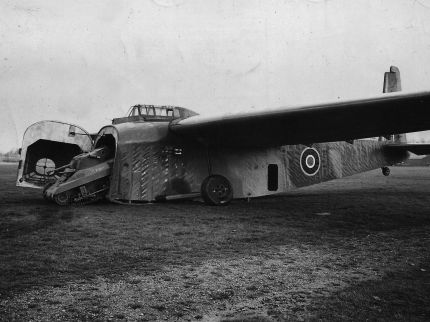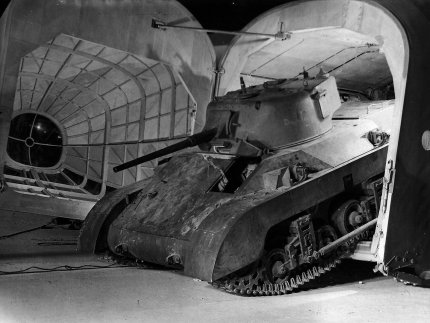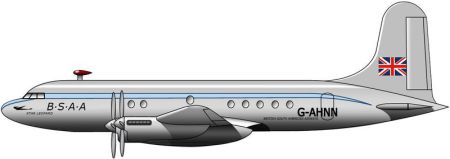
Header photo from TRADA
Langley Airfield
Langley Airfield was built on Parlaunt Farm in 1938 for Hawker Aircraft Ltd. A factory was built on the site to produce Hawker aircraft. The main runway was a grass strip 05/23 and 1,289yds (as of 1951) long, possibly reduced from 1,400yds. Two other grass runaways 10/28 of 1,100yds long and 17/35 of 984yds and the three runways were quite wide at around 197yds.
Second World War
During the Second World War, the airfield retained a Hurricane for its self-defence, it thankfully was never needed. Another defensive measure was the installation of a series of drums around the perimeter. If it was felt that an air raid was imminent, the contents of the drums would be burned and the resultant smoke would cover and hide the airfield.
It was a great idea except that more often than not the smoke cloud would drift away from the airfield and cover pretty much the whole of Slough in smoke creating all sorts of chaos. Considering the importance of the airfield for development and manufacture of Hawker aircraft and other military use, the airfield survived the war relatively unscathed. Here’s a memory from a reader:
‘My father William Tyrie worked at the airfield during the early part of the war before being called up. He told me that the factory was hit by a bomb, which went through the roof and hit a purlin or longitudinal member in the roof frame, the casing split open and did not explode. He and others spent time sweeping up the explosive powder for disposal.
Similarly he spoke of the airfield being bombed and having to measure the distance between the craters for others to estimate the height and speed of the bombers. Similarly, and it may have been the same occasion, he told me about the line of craters heading from the airfield towards where we were living in at 103 Meadfield Road, where by an act of god, the spacing of the craters indicated that a bomb should have hit our house, but did not. The line of craters continued beyond where we were living.
I also have a cousin who lived on the opposite side of the road at 142 Meadfield Road, backing onto the airfield where one of the tanks containing fuel to create smoke was situated and she remembers the pall of smoke it generated when the sirens sounded.’
Charles Tyrie
Significant first flights
Tornado PS219 6 October 1939
Typhoon PS212 24 February 1940
Tempest V HM595 2 September 1942
Fury F.2/43 NX798 1 September 1944
RAF Film Production Unit (RAFFPU)
The RAF Film Production Unit was formed in 1941 and mainly headquartered at Pinewood Studios. The unit produced films to document the RAF’s work in the air and on the ground as well as to produce propaganda films during the Second World War. It had a number of aircraft of various types based at RAF Benson and RAF Langley including Bristol Beaufort, Avro Anson, Lockheed Hudson, Douglas Havoc and Auster aircraft. One source of my research suggests that Langley had at least four Havocs based there.
An example of a Douglas Havoc. This is a bomber version from a different unit. The aircraft types used by the RAFFPU would no doubt have been adapted from machines no longer required for ‘front line’ service.
Among the personnel with RAFFPU was Richard Attenborough who served under the command of Flight Lieutenant John Boulting (of the Boulting Brothers). Qualifying as sergeant, Attenborough flew a number of missions over Europe in the rear gunner’s position of various aircraft filming the outcome of Bomber Command sorties.
John Boulting joined the RAFFPU and became a flight lieutenant. Among other projects he worked on was the dramatised documentary movie Journey Together (1945) which followed the training and careers of two bomber crew. The film starred Richard Attenborough and was written by Boulting and Terence Rattigan. It was directed and produced by Boulting.
Filming by the RAFFPU ended in 1945 and the unit was stood down at RAF Stanmore Park in March 1947. It then became the Film Production Unit Library.
Personnel from the unit were sometimes present on raids, notably Operation Jericho, a raid on Amiens prison which was an attempt to free members of the French Resistance who were under threat of imminent execution. Personnel on this raid may not have been from Langley.
General Aircraft Hamilcar X
The Hamilcar X had a range of 1,675 miles and a maximum speed under its own power of 145mph.
The General Aircraft Hamilcar Mk X was constructed at Langley Airfield. It was a propeller-powered version of the Hamilcar I assault glider that was used during the Normandy landings by the Allied forces in World War Two. The engines were added so as to extend the range of the glider. It was thought that this might prove effective especially for use on Japanese occupied islands in the Pacific War. However, the war against Japan ended before the Hamilcar was needed.
A non-powered Hamilcar unloading a Locust tank
The Hamilcar had been designed to transport a single light tank, typically a Tetrarch or later a M22 Locust, or two Universal Carriers, commonly known as Bren Carriers, or one Universal Carrier and an anti-tank gun. Because of the lack of space, tank crews would travel to the destination in their vehicles as boarding them in flight was virtually impossible.
A display of a Locust tank emerging from the hold of a Hamilcar.
Many thanks to Dave Scott for additional information and photographs on this article.
Post-War
Airwork Limited
Another company involved in aircraft activity, Airwork Services, moved its headquarters to Langley Airfield in 1947 from Gatwick.
The company was originally formed at the new Heston Aerodrome in 1928 and before moving to Langley, the company had been responsible for setting up the national airlines United Arab Airlines, Indian Airlines and Central African Airways.
Vickers Viking I G-AIXR
The Vickers Viking carried 36 passengers and was powered by two 1,690hp Bristol Hercules 634 radial engines giving a cruising speed of 210mph (top speed 263mph) and a range of 1,700 miles. 163 were built and flew with airlines around the world. In the post-war era, Airwork operated the following aircraft types:
Handley Page Hermes G-ALDA of Airwork London
Apart from the airline, the company’s activities diversified over the years as an airline, a flying training provider for the RAF, manufacture of aircraft parts such as wings for Lancaster bombers, maintenance of several aircraft types and aerial photography (Aerofilms Ltd). Apart from its maintenance base at Langley and Elementary Flying schools set up for the RAF, Airworks had operations at Blackbushe and Lasham. In summer 1959, Airwork relocated its headquarters from Langley to Hurn. The company still exists today as a wholly-owned subsidiary of VT Group.
Apart from the airline, the company’s activities diversified over the years as an airline, a flying training provider for the RAF, manufacture of aircraft parts such as wings for Lancaster bombers, maintenance of several aircraft types and aerial photography (Aerofilms Ltd). Apart from its maintenance base at Langley and Elementary Flying schools set up for the RAF, Airworks had operations at Blackbushe and Lasham. In summer 1959, Airwork relocated its headquarters from Langley to Hurn. The company still exists today as a wholly-owned subsidiary of VT Group.
British South American Airways
State-owned airline British South American Airways (BSAA) was formed in January 1944 flying operations out of the new Heathrow Airport. Post-war the company used Langley Airfield by as a maintenance base.
The BSAA fleet included: ten Avro Lancastrian and six Avro Tudor for passengers; four converted Lancaster and seven Avro Tudor for freight; two Airspeed Consul and one Airspeed Oxford for navigation and radio training; and an Avro 19 and a Percival Proctor for company transport.
Avro Tudor G-AHNN ‘Star Leopard’ of BSAA
The Avro Tudor was Britain’s first pressurised airliner. It was powered by four 1,170 hp Rolls-Royce Merlin 100 engines giving a cruising speed of 283mph at 12,000ft (top speed 320 mph). The Tudor IV carried 32 passengers.
Two of BSAAs Avro Tudor aircraft were among the first to disappear over the area that was to become known as the Bermuda Triangle. G-AHNP Star Tiger made its last communication on 31st January 1948 and G-AGRE Star Ariel disappeared on 17th January 1949. Despite large searches being made no trace of either aircraft was ever found.
The maintenance operations were eventually transferred to Heathrow and the company became part of British Overseas Airways Corporation (BOAC).
Silver City Airways
Silver City Airways was a private British civil airline established in November 1946 at Langley Airfield. The first aircraft types were four ex-military Douglas Dakotas and three Avro Lancastrians. The airline’s first commercial flight was by Lancastrian G-AHBW which took off in late 1946 from Heathrow Airport for Sydney via Johannesburg. When Langley closed in 1947 the airline moved its headquarters to Blackbushe.
Avro Lancastrian G-AHBV City of Canberra
The Lancastrian had capacity for 9 passengers or 3,560kg of freight as a mail plane. Powered by four 1,250hp Rolls-Royce Merlin piston engines, could achieve a top speed of 310mph and had a range of 4,150 miles. 91 aircraft were built or converted from Lancaster bombers.
Skyways Limited
The name Skyways was first applied to a company which provided instruction in aviation, navigation and signalling.
In 1946 the airline Skyways was formed at Langley airfield and would soon become the largest operator of non-scheduled air services in Europe. It was particularly active in charter flights for the British military, the oil industry and specialist freight services.
The company’s first flight took place in 1946 when an Avro York carried personnel and freight for the Anglo-Iranian Oil Company from Langley Airfield to Basra. In those early days of civilian airlines and the limitations of the aircraft the flight included stops at Manston in Kent (because Langley had no customs facilities), Malta, Cairo (overnight stopover) and Lydda. The route became a regular contract service with two return flights per week and each trip took 4 days to complete with 35 flying hours.
Skyways was a major participant in the Berlin Airlift of 1948-49 using committing three York and four Lancastrian aircraft to transport supplies into the blockaded city. In 1950 the War Office awarded contracts to the airline for the transport of troops chiefly to Singapore and the Far East. Its engineering division refurbished ex-RAF Spitfires and Hurricane fighter for the Portuguese air force. Skyways also increased its civilian charter flight operations and later added Bristol 170 car transporters to its fleet. At its height it became the largest charter airline in Europe. The aircraft fleet over time included:
- Avro Lancastrian
- Avro 685 York
- de Havilland Dragon Rapide
- de Havilland Dove
- Douglas DC-3/C-47
- Douglas DC-4/C-54
- Fairchild Hiller FH-227
- Handley Page HP.81 Hermes
- Lockheed L-749A Constellation
Avro York G-AMGK
The York was another aircraft developed from the Lancaster bomber. Its wider fuselage had a capacity for 56 passengers or a payload of 9,100kg. It was powered by four 1,280hp Rolls-Royce Merlin engines giving a top speed of 298mph and a range of 3,000 miles. 259 were built including prototypes.
By November 1946 Skyways moved its main operations to Dunsfold Airfield near Guildford. At some point the airline established Samlesbury Engineering at Dunsfold to handle its maintenance needs.
Langley Airfield closure
The map shows that the part or the Hawker factory on the south-east side of the airfield was leased to Ford motors. The proximity of the developing Heathrow Airport, and the fact that Langley only had a grass runway and were entering the jet age, contributed to the demise of the airfield. According to the control tower records, the last recorded aircraft movement on the airfield was in 1956.
From 1951, Hawker began shifting aircraft production to Dunsfold Aerodrome, Surrey. The company continued manufacturing operations at Langley with most of the major assembly work on Sea Hawks and Hunters being done there. These components were then taken by road for final assembly at Dunsfold until about 1958.
Many of the airlines mentioned on this page had already moved their maintenance operations to other airfields such as Dunsfold and Blackbushe. The factory and site was eventually taken over by Ford Commercial Vehicles.
The site of the airfield was being redeveloped a long time before Ford left in 1997 into an industrial area and a housing estate. All that remains of the airfield now is the electricity substation rated at 33/11kV which I believe still bears the name Hawker Aircraft.
Group Captain PWS ‘George’ Bulman
Hawker’s chief test pilot Group Captain PWS ‘George’ Bulman flew the prototype Hurricane K5083 from Brooklands on 6 November 1935. He also did the flight testing on the final production Hurricane PZ865, ‘The Last of the Many’, which was completed on 27 July 1944.
My name is Gary Flint. I'm author, photographer & illustrator for Postcards from Slough. If you wish to make any comments on the contents of the website please click on the ladybird below:
Gary Flint
08/03/1961 - 09/04/2019
Postcards from Slough is an independently funded website. We are open to offers of sponsorship from companies that have any connections to the town. To contact us please click on the ladybird below:
Chalvey Community Forum
Postcards from Slough is linked with a local action group the Chalvey Community Forum. The group liaises with various local organisations in order to improve the quality of life for residents in the ward of Chalvey and Salt Hill. To learn more please click on the maidenhair leaf below:
Museum of Berkshire Aviation
I volunteer as a guide at the Museum of Berkshire Aviation. It is a special museum and if you would like to know more about the museum then please click on the motif below:
To learn more about the museums activities while staying within this website click on the tab at the top of the page or on the motif below:
Graces Guide
Postcards from Slough uses some images from Grace's Guide. Click on the button below:
British Listed Buildings
Postcards from Slough contributes material to British Listed Buildings and uses the site for cross referencing purposes. Click on the button below:
















